Globalization in Management and Organizations: Friedman vs. Ghemawat
VerifiedAdded on 2020/03/04
|7
|1386
|254
Discussion Board Post
AI Summary
This paper offers a comparative analysis of Thomas Friedman's and Pankaj Ghemawat's views on globalization. The student's assignment begins by summarizing Friedman's 'three eras of globalization' and his argument for a 'flat world' driven by technology. The paper then contrasts this with Ghemawat's perspective, which posits a 'semi-globalized' world with limited connections between economies and countries. The student explores the drawbacks of a flat world, such as famine and economic competition, while also discussing the role of technology in shaping these dynamics. The assignment concludes by agreeing with Ghemawat's view that the world is not entirely flat, highlighting limitations and challenges in globalization based on cultural differences and other factors. The paper references e-learning activities and relevant sources to support its arguments, offering a comprehensive discussion of the complexities of globalization from a management perspective.
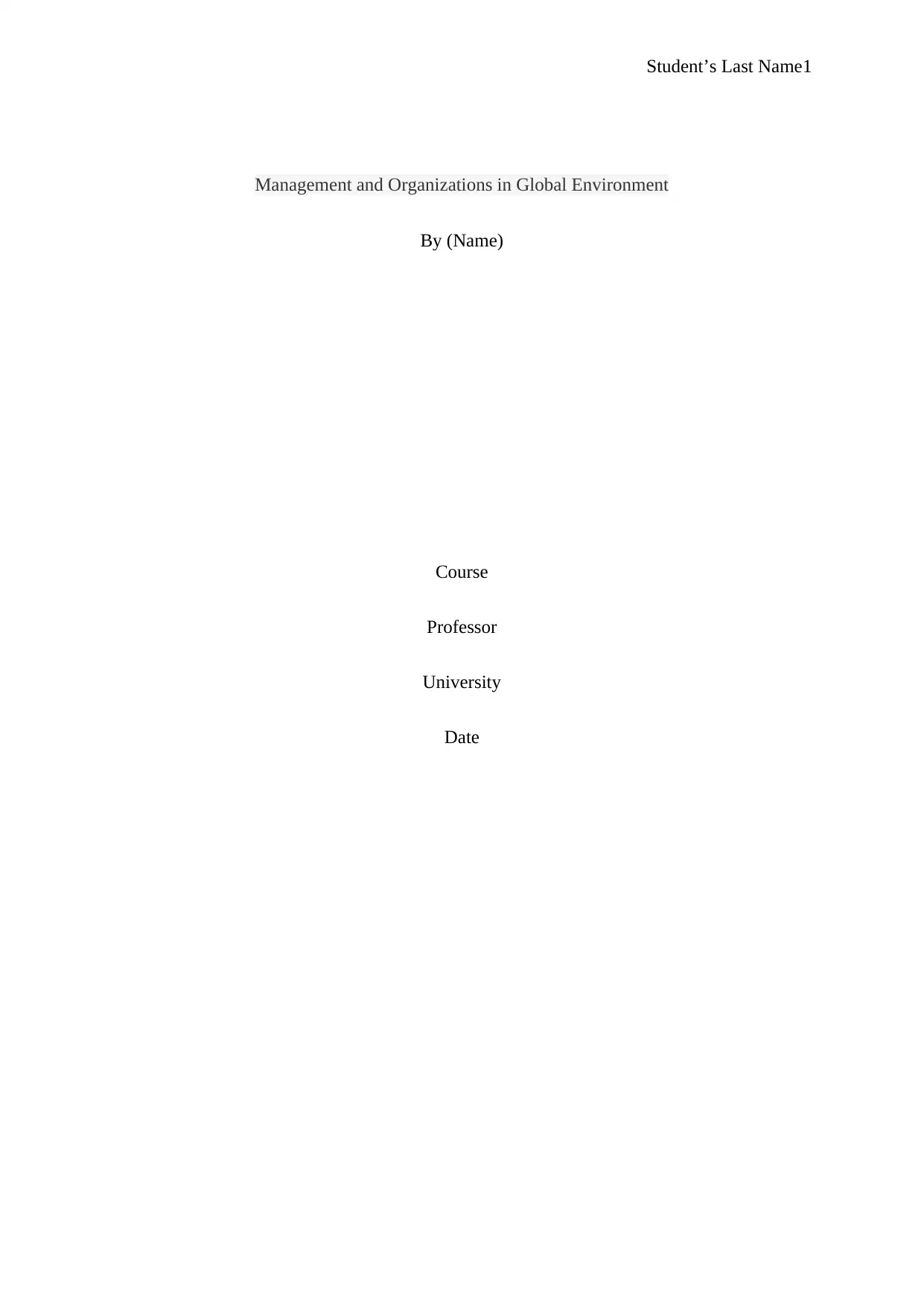
Student’s Last Name1
Management and Organizations in Global Environment
By (Name)
Course
Professor
University
Date
Management and Organizations in Global Environment
By (Name)
Course
Professor
University
Date
Paraphrase This Document
Need a fresh take? Get an instant paraphrase of this document with our AI Paraphraser
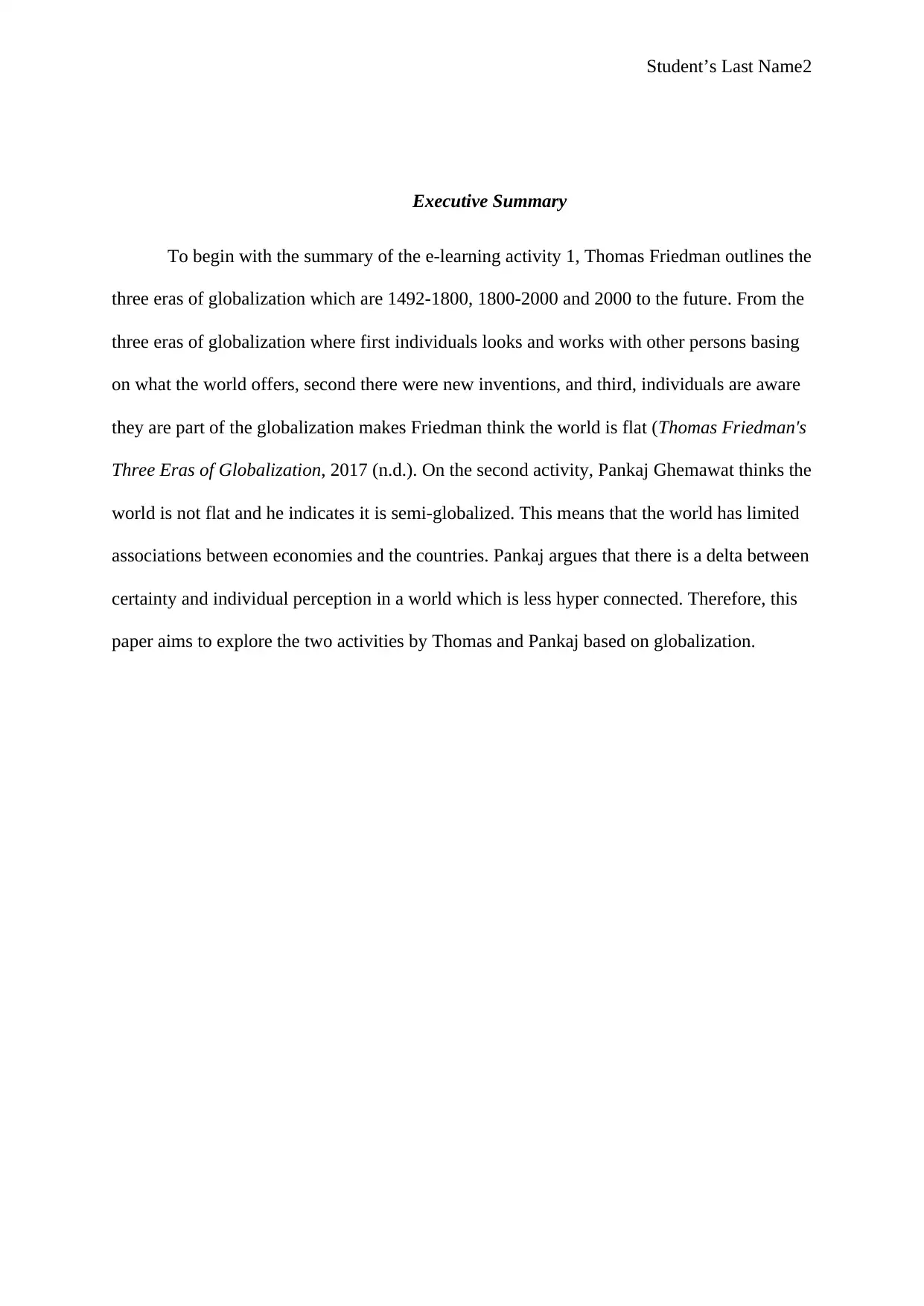
Student’s Last Name2
Executive Summary
To begin with the summary of the e-learning activity 1, Thomas Friedman outlines the
three eras of globalization which are 1492-1800, 1800-2000 and 2000 to the future. From the
three eras of globalization where first individuals looks and works with other persons basing
on what the world offers, second there were new inventions, and third, individuals are aware
they are part of the globalization makes Friedman think the world is flat (Thomas Friedman's
Three Eras of Globalization, 2017 (n.d.). On the second activity, Pankaj Ghemawat thinks the
world is not flat and he indicates it is semi-globalized. This means that the world has limited
associations between economies and the countries. Pankaj argues that there is a delta between
certainty and individual perception in a world which is less hyper connected. Therefore, this
paper aims to explore the two activities by Thomas and Pankaj based on globalization.
Executive Summary
To begin with the summary of the e-learning activity 1, Thomas Friedman outlines the
three eras of globalization which are 1492-1800, 1800-2000 and 2000 to the future. From the
three eras of globalization where first individuals looks and works with other persons basing
on what the world offers, second there were new inventions, and third, individuals are aware
they are part of the globalization makes Friedman think the world is flat (Thomas Friedman's
Three Eras of Globalization, 2017 (n.d.). On the second activity, Pankaj Ghemawat thinks the
world is not flat and he indicates it is semi-globalized. This means that the world has limited
associations between economies and the countries. Pankaj argues that there is a delta between
certainty and individual perception in a world which is less hyper connected. Therefore, this
paper aims to explore the two activities by Thomas and Pankaj based on globalization.
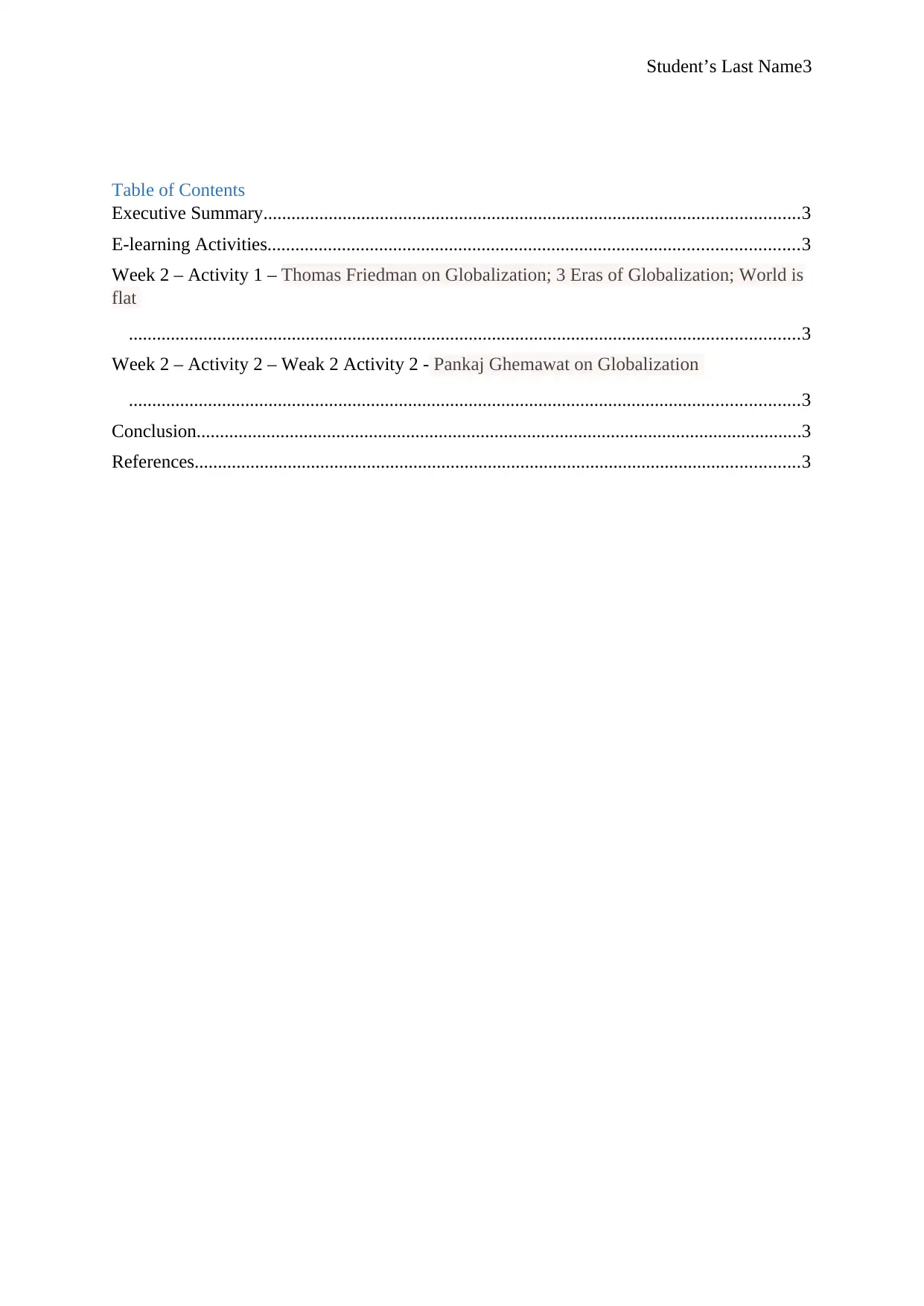
Student’s Last Name3
Table of Contents
Executive Summary...................................................................................................................3
E-learning Activities..................................................................................................................3
Week 2 – Activity 1 – Thomas Friedman on Globalization; 3 Eras of Globalization; World is
flat
................................................................................................................................................3
Week 2 – Activity 2 – Weak 2 Activity 2 - Pankaj Ghemawat on Globalization
................................................................................................................................................3
Conclusion..................................................................................................................................3
References..................................................................................................................................3
Table of Contents
Executive Summary...................................................................................................................3
E-learning Activities..................................................................................................................3
Week 2 – Activity 1 – Thomas Friedman on Globalization; 3 Eras of Globalization; World is
flat
................................................................................................................................................3
Week 2 – Activity 2 – Weak 2 Activity 2 - Pankaj Ghemawat on Globalization
................................................................................................................................................3
Conclusion..................................................................................................................................3
References..................................................................................................................................3
⊘ This is a preview!⊘
Do you want full access?
Subscribe today to unlock all pages.

Trusted by 1+ million students worldwide
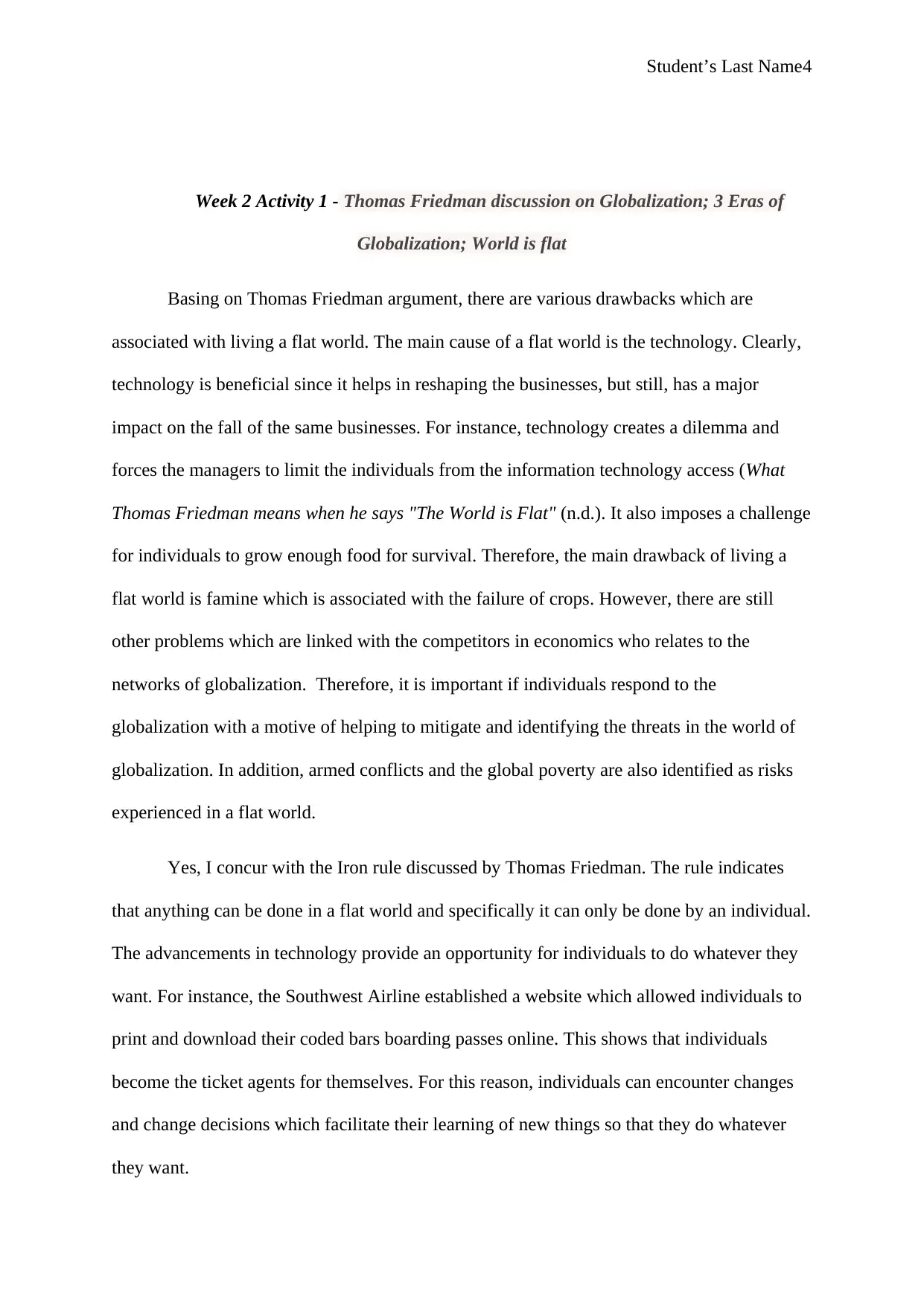
Student’s Last Name4
Week 2 Activity 1 - Thomas Friedman discussion on Globalization; 3 Eras of
Globalization; World is flat
Basing on Thomas Friedman argument, there are various drawbacks which are
associated with living a flat world. The main cause of a flat world is the technology. Clearly,
technology is beneficial since it helps in reshaping the businesses, but still, has a major
impact on the fall of the same businesses. For instance, technology creates a dilemma and
forces the managers to limit the individuals from the information technology access (What
Thomas Friedman means when he says "The World is Flat" (n.d.). It also imposes a challenge
for individuals to grow enough food for survival. Therefore, the main drawback of living a
flat world is famine which is associated with the failure of crops. However, there are still
other problems which are linked with the competitors in economics who relates to the
networks of globalization. Therefore, it is important if individuals respond to the
globalization with a motive of helping to mitigate and identifying the threats in the world of
globalization. In addition, armed conflicts and the global poverty are also identified as risks
experienced in a flat world.
Yes, I concur with the Iron rule discussed by Thomas Friedman. The rule indicates
that anything can be done in a flat world and specifically it can only be done by an individual.
The advancements in technology provide an opportunity for individuals to do whatever they
want. For instance, the Southwest Airline established a website which allowed individuals to
print and download their coded bars boarding passes online. This shows that individuals
become the ticket agents for themselves. For this reason, individuals can encounter changes
and change decisions which facilitate their learning of new things so that they do whatever
they want.
Week 2 Activity 1 - Thomas Friedman discussion on Globalization; 3 Eras of
Globalization; World is flat
Basing on Thomas Friedman argument, there are various drawbacks which are
associated with living a flat world. The main cause of a flat world is the technology. Clearly,
technology is beneficial since it helps in reshaping the businesses, but still, has a major
impact on the fall of the same businesses. For instance, technology creates a dilemma and
forces the managers to limit the individuals from the information technology access (What
Thomas Friedman means when he says "The World is Flat" (n.d.). It also imposes a challenge
for individuals to grow enough food for survival. Therefore, the main drawback of living a
flat world is famine which is associated with the failure of crops. However, there are still
other problems which are linked with the competitors in economics who relates to the
networks of globalization. Therefore, it is important if individuals respond to the
globalization with a motive of helping to mitigate and identifying the threats in the world of
globalization. In addition, armed conflicts and the global poverty are also identified as risks
experienced in a flat world.
Yes, I concur with the Iron rule discussed by Thomas Friedman. The rule indicates
that anything can be done in a flat world and specifically it can only be done by an individual.
The advancements in technology provide an opportunity for individuals to do whatever they
want. For instance, the Southwest Airline established a website which allowed individuals to
print and download their coded bars boarding passes online. This shows that individuals
become the ticket agents for themselves. For this reason, individuals can encounter changes
and change decisions which facilitate their learning of new things so that they do whatever
they want.
Paraphrase This Document
Need a fresh take? Get an instant paraphrase of this document with our AI Paraphraser
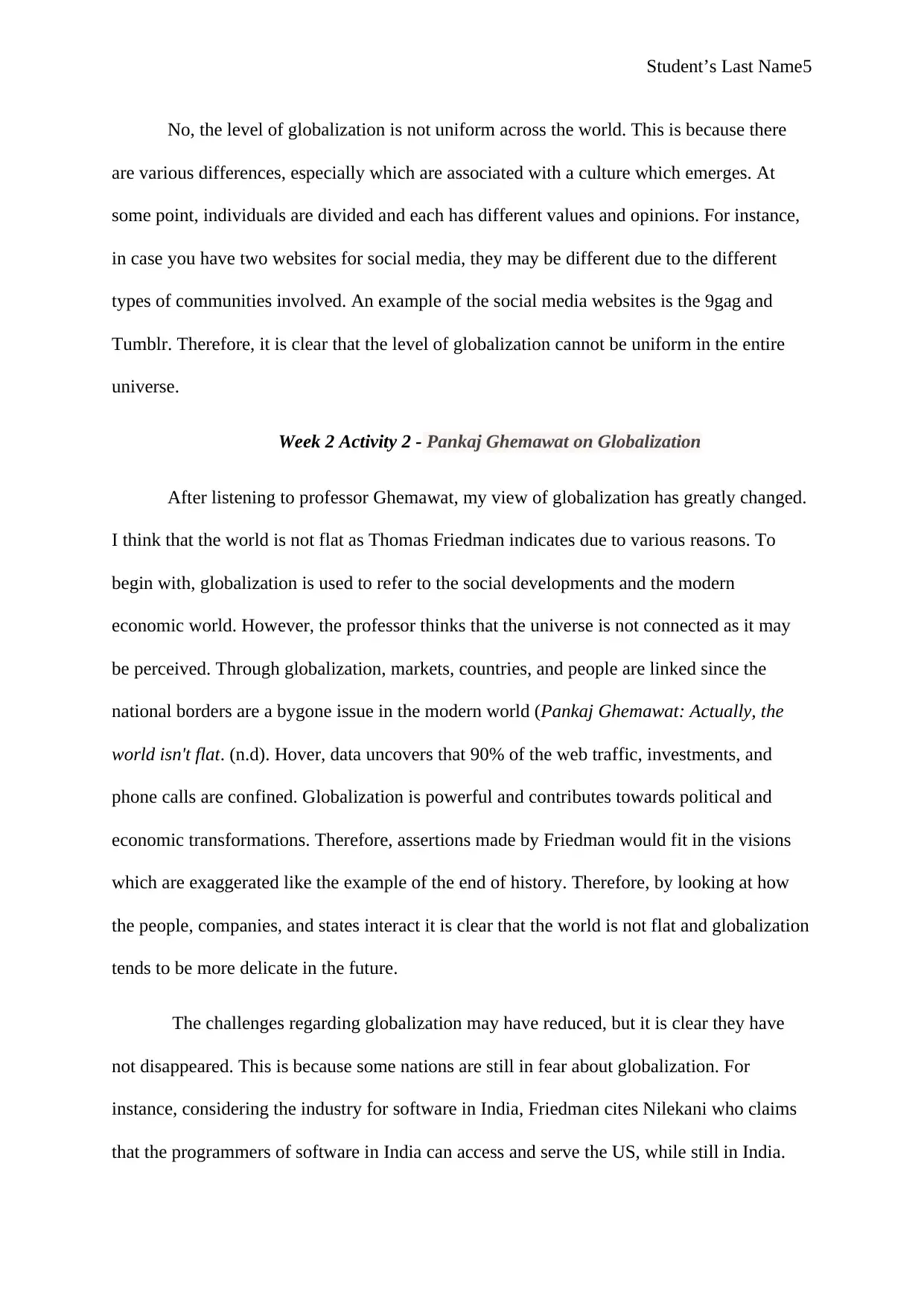
Student’s Last Name5
No, the level of globalization is not uniform across the world. This is because there
are various differences, especially which are associated with a culture which emerges. At
some point, individuals are divided and each has different values and opinions. For instance,
in case you have two websites for social media, they may be different due to the different
types of communities involved. An example of the social media websites is the 9gag and
Tumblr. Therefore, it is clear that the level of globalization cannot be uniform in the entire
universe.
Week 2 Activity 2 - Pankaj Ghemawat on Globalization
After listening to professor Ghemawat, my view of globalization has greatly changed.
I think that the world is not flat as Thomas Friedman indicates due to various reasons. To
begin with, globalization is used to refer to the social developments and the modern
economic world. However, the professor thinks that the universe is not connected as it may
be perceived. Through globalization, markets, countries, and people are linked since the
national borders are a bygone issue in the modern world (Pankaj Ghemawat: Actually, the
world isn't flat. (n.d). Hover, data uncovers that 90% of the web traffic, investments, and
phone calls are confined. Globalization is powerful and contributes towards political and
economic transformations. Therefore, assertions made by Friedman would fit in the visions
which are exaggerated like the example of the end of history. Therefore, by looking at how
the people, companies, and states interact it is clear that the world is not flat and globalization
tends to be more delicate in the future.
The challenges regarding globalization may have reduced, but it is clear they have
not disappeared. This is because some nations are still in fear about globalization. For
instance, considering the industry for software in India, Friedman cites Nilekani who claims
that the programmers of software in India can access and serve the US, while still in India.
No, the level of globalization is not uniform across the world. This is because there
are various differences, especially which are associated with a culture which emerges. At
some point, individuals are divided and each has different values and opinions. For instance,
in case you have two websites for social media, they may be different due to the different
types of communities involved. An example of the social media websites is the 9gag and
Tumblr. Therefore, it is clear that the level of globalization cannot be uniform in the entire
universe.
Week 2 Activity 2 - Pankaj Ghemawat on Globalization
After listening to professor Ghemawat, my view of globalization has greatly changed.
I think that the world is not flat as Thomas Friedman indicates due to various reasons. To
begin with, globalization is used to refer to the social developments and the modern
economic world. However, the professor thinks that the universe is not connected as it may
be perceived. Through globalization, markets, countries, and people are linked since the
national borders are a bygone issue in the modern world (Pankaj Ghemawat: Actually, the
world isn't flat. (n.d). Hover, data uncovers that 90% of the web traffic, investments, and
phone calls are confined. Globalization is powerful and contributes towards political and
economic transformations. Therefore, assertions made by Friedman would fit in the visions
which are exaggerated like the example of the end of history. Therefore, by looking at how
the people, companies, and states interact it is clear that the world is not flat and globalization
tends to be more delicate in the future.
The challenges regarding globalization may have reduced, but it is clear they have
not disappeared. This is because some nations are still in fear about globalization. For
instance, considering the industry for software in India, Friedman cites Nilekani who claims
that the programmers of software in India can access and serve the US, while still in India.
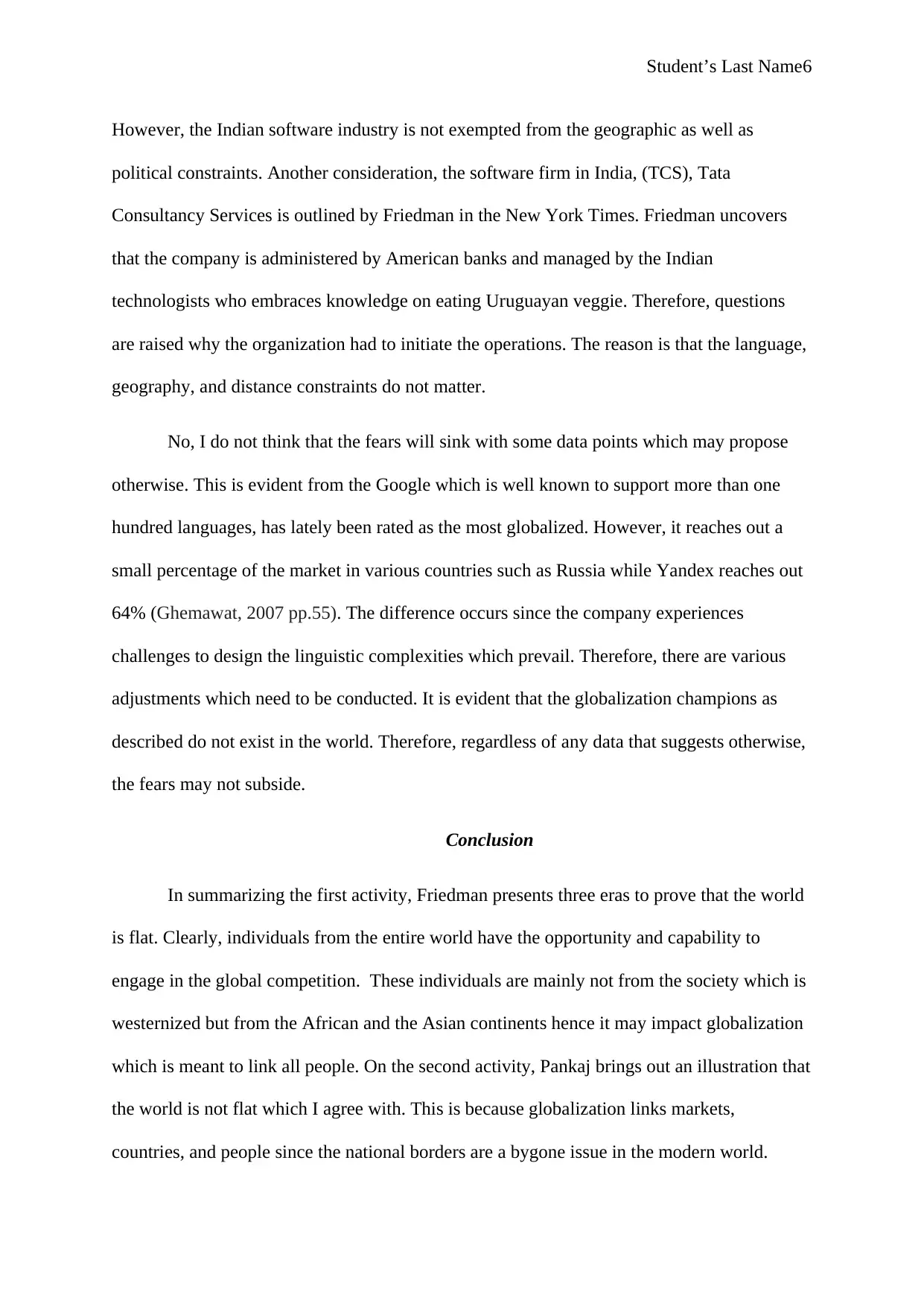
Student’s Last Name6
However, the Indian software industry is not exempted from the geographic as well as
political constraints. Another consideration, the software firm in India, (TCS), Tata
Consultancy Services is outlined by Friedman in the New York Times. Friedman uncovers
that the company is administered by American banks and managed by the Indian
technologists who embraces knowledge on eating Uruguayan veggie. Therefore, questions
are raised why the organization had to initiate the operations. The reason is that the language,
geography, and distance constraints do not matter.
No, I do not think that the fears will sink with some data points which may propose
otherwise. This is evident from the Google which is well known to support more than one
hundred languages, has lately been rated as the most globalized. However, it reaches out a
small percentage of the market in various countries such as Russia while Yandex reaches out
64% (Ghemawat, 2007 pp.55). The difference occurs since the company experiences
challenges to design the linguistic complexities which prevail. Therefore, there are various
adjustments which need to be conducted. It is evident that the globalization champions as
described do not exist in the world. Therefore, regardless of any data that suggests otherwise,
the fears may not subside.
Conclusion
In summarizing the first activity, Friedman presents three eras to prove that the world
is flat. Clearly, individuals from the entire world have the opportunity and capability to
engage in the global competition. These individuals are mainly not from the society which is
westernized but from the African and the Asian continents hence it may impact globalization
which is meant to link all people. On the second activity, Pankaj brings out an illustration that
the world is not flat which I agree with. This is because globalization links markets,
countries, and people since the national borders are a bygone issue in the modern world.
However, the Indian software industry is not exempted from the geographic as well as
political constraints. Another consideration, the software firm in India, (TCS), Tata
Consultancy Services is outlined by Friedman in the New York Times. Friedman uncovers
that the company is administered by American banks and managed by the Indian
technologists who embraces knowledge on eating Uruguayan veggie. Therefore, questions
are raised why the organization had to initiate the operations. The reason is that the language,
geography, and distance constraints do not matter.
No, I do not think that the fears will sink with some data points which may propose
otherwise. This is evident from the Google which is well known to support more than one
hundred languages, has lately been rated as the most globalized. However, it reaches out a
small percentage of the market in various countries such as Russia while Yandex reaches out
64% (Ghemawat, 2007 pp.55). The difference occurs since the company experiences
challenges to design the linguistic complexities which prevail. Therefore, there are various
adjustments which need to be conducted. It is evident that the globalization champions as
described do not exist in the world. Therefore, regardless of any data that suggests otherwise,
the fears may not subside.
Conclusion
In summarizing the first activity, Friedman presents three eras to prove that the world
is flat. Clearly, individuals from the entire world have the opportunity and capability to
engage in the global competition. These individuals are mainly not from the society which is
westernized but from the African and the Asian continents hence it may impact globalization
which is meant to link all people. On the second activity, Pankaj brings out an illustration that
the world is not flat which I agree with. This is because globalization links markets,
countries, and people since the national borders are a bygone issue in the modern world.
⊘ This is a preview!⊘
Do you want full access?
Subscribe today to unlock all pages.

Trusted by 1+ million students worldwide
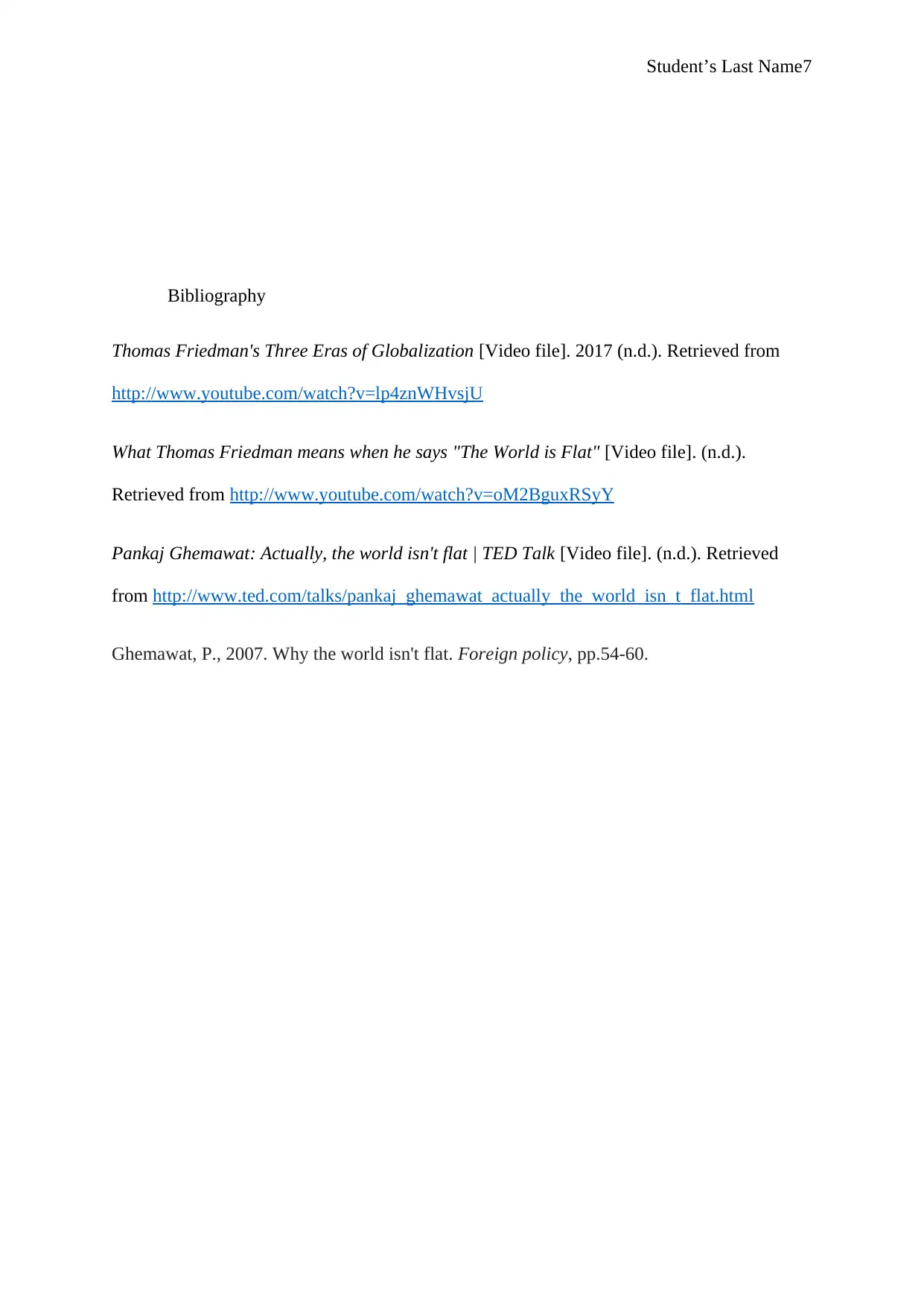
Student’s Last Name7
Bibliography
Thomas Friedman's Three Eras of Globalization [Video file]. 2017 (n.d.). Retrieved from
http://www.youtube.com/watch?v=lp4znWHvsjU
What Thomas Friedman means when he says "The World is Flat" [Video file]. (n.d.).
Retrieved from http://www.youtube.com/watch?v=oM2BguxRSyY
Pankaj Ghemawat: Actually, the world isn't flat | TED Talk [Video file]. (n.d.). Retrieved
from http://www.ted.com/talks/pankaj_ghemawat_actually_the_world_isn_t_flat.html
Ghemawat, P., 2007. Why the world isn't flat. Foreign policy, pp.54-60.
Bibliography
Thomas Friedman's Three Eras of Globalization [Video file]. 2017 (n.d.). Retrieved from
http://www.youtube.com/watch?v=lp4znWHvsjU
What Thomas Friedman means when he says "The World is Flat" [Video file]. (n.d.).
Retrieved from http://www.youtube.com/watch?v=oM2BguxRSyY
Pankaj Ghemawat: Actually, the world isn't flat | TED Talk [Video file]. (n.d.). Retrieved
from http://www.ted.com/talks/pankaj_ghemawat_actually_the_world_isn_t_flat.html
Ghemawat, P., 2007. Why the world isn't flat. Foreign policy, pp.54-60.
1 out of 7
Related Documents
Your All-in-One AI-Powered Toolkit for Academic Success.
+13062052269
info@desklib.com
Available 24*7 on WhatsApp / Email
![[object Object]](/_next/static/media/star-bottom.7253800d.svg)
Unlock your academic potential
Copyright © 2020–2025 A2Z Services. All Rights Reserved. Developed and managed by ZUCOL.



